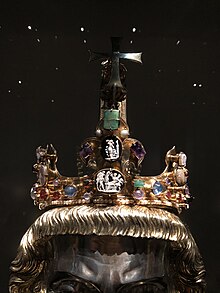Charlemagne
The Karl bust is a created around 1350 reliquary in the form of a bust of Charlemagne where his skull as a relic to be preserved. The reliquary belongs to the late medieval furnishings of the Aachen Cathedral and is kept in the Aachen Cathedral Treasury . The bust of Charlemagne is considered to be one of the most important examples of Gothic goldsmithing and the most famous relic bust of all. This is an ideal image , not a portrait of Charlemagne.
description
The bust reliquary consists of chased silver and is partly gilded . The reliquary encloses a human skull - according to tradition, that of Charlemagne. It depicts the bust of the emperor, the head adorned with a gem-studded golden lily crown, which, according to a document from 1262 by Richard of Cornwall, was given "for ever" to the Aachen Minster (today cathedral) ; it was extensively restored in 1873 by August Witte . The hair and beard areas are gold-plated, the face and neck are accentuated in embossed silver. The breastplate is adorned with silver eagle inlaid - the imperial eagle on the gold background of the robe as the heraldic animal of the Holy Roman Empire indicates the dignity of the emperor - as well as filigree and precious stone borders ; some of the gemstones are antique gems . The bust of Charlemagne stands on an octagonal base with two openings on the flanks for a wooden support, which is decorated with heraldic lilies - a symbol of French royal rule and thus an expression of the self-image of a founder who ultimately saw himself as the successor of Charlemagne.
Starting with the bust of Charlemagne as a high point in Rhineland-Maasland goldsmithing, not only in the Middle Ages, a heyday of silver-gilded, naturalistically designed bust reliquaries began.
history
According to the Aachen tradition, the bust of Karl is considered the foundation of Charles IV , who was crowned king on July 25, 1349 in Aachen Cathedral . Although this foundation is not mentioned in a document , it can be regarded as quite possible, which is explained by its deep admiration for Charlemagne. The reliquary stands in the tradition of French depictions of kings of the 13th century and represents an artistic idealization of the Frankish emperor, although it also has individualizing facial features. The latter are also noticeable in a similar way in a portrait of John II of France . It is possible that the creator of the bust reliquary, an Aachen goldsmith , was an artist trained in France. The reliquary was carried in processions and carried to the incoming king at coronations, who in this way was received spiritually by him as the legitimate successor of Charlemagne and, as the new ruler, worshiped the relic of his ancestor.
The use of antique gems and cameos for reliquaries and crowns indicates a reference to Roman antiquity , which was essential for the medieval imperial idea , in whose tradition Charlemagne and later Charles IV saw themselves in their rulership role. Recent historical research assumes likely that Charles IV with the carried by the Karlseliquiar crown -. Instead of at that time in possession of Ludwig of Bavaria located or his heirs imperial crown was crowned -. On the occasion of the coronation , the central bow with the cross was added. In 1414, Sigismund of Luxembourg was crowned with the now modified crown. A parallel to this crown can be seen in the Prague Wenceslas Crown , which adorned the skull relic of Wenceslas of Bohemia and was also used for coronations.
present
Even today, the Büstenreliquiar Charles finds the Great liturgical use in the Karl festival and the Feast Ascension , including the bust is placed in the cathedral. Traditionally, this takes place on the latter holiday with a view to the annual awarding of the International Charlemagne Prize in Aachen , which honors outstanding personalities who have made a contribution to the promotion of European integration .
The bust of Charlemagne is a popular motif that is often used in connection with Charlemagne. Due to its recognition value for the city of Aachen and its high ideological and art-historical importance , it serves in stylized form as a central element in the logo of the Charlemagne Prize Foundation.
literature
- Ernst Günther Grimme (text), Ann Bredol-Lepper (photos): Aachen goldsmithing in the Middle Ages. Seemann, Cologne 1957, pp. 69-72.
- Ernst Günther Grimme (text), Ann Bredol-Lepper (recordings): The great centuries of Aachen goldsmithing (= Aachener Kunstblätter. Vol. 26). Verlag des Aachener Museumsverein, Aachen 1962, pp. 65, 74–75.
- Ernst Günther Grimme (text), Ann Münchow (recordings): The Aachen Cathedral Treasure (= Aachener Kunstblätter. Vol. 42). Schwann, Düsseldorf 1973, No. 69, pp. 88-90.
- Birgitta Falk : Portrait reliquaries. On the origin and development of the metal head, bust and half-figure reliquaries in the Middle Ages. In: Aachener Kunstblätter. Vol. 59, DuMont Schauberg, Cologne 1991-93, pp. 99-238.
- Ernst Günther Grimme (text), Ann Münchow (recordings): The Aachen Cathedral. Architecture and equipment. Einhard, Aachen 1994, ISBN 978-3-920284-87-3 , pp. 165, 215-218.
- Herta Lepie , Georg Minkenberg : The Treasury of Aachen Cathedral , Brimberg, Aachen 1995, ISBN 3-923773-16-1 , p. 27.
- Ernst Günther Grimme: The Aachen Cathedral. Einhard, Aachen 2000, ISBN 978-3-930701-75-9 , pp. 95-97.
- Herta Lepie: The Aachen Cathedral Treasure. In: Clemens MM Bayer, Dominik M. Meiering , Martin Seidler, Martin Struck (eds.): Treasure art in Rhenish churches and museums. Schnell & Steiner, Regensburg 2013, ISBN 978-3-7954-2827-3 , pp. 121–137, here pp. 127–128.
- Walter Maas, Pit Siebigs: The Aachen Cathedral. Schnell & Steiner, Regensburg 2013, ISBN 978-3-7954-2445-9 , pp. 158–160.
Web links
Remarks
- ↑ Klaus Gereon Beuckers: The Essen Marsus shrine. Aschendorff, Münster 2006, ISBN 3-402-06251-8 , p. 30.



